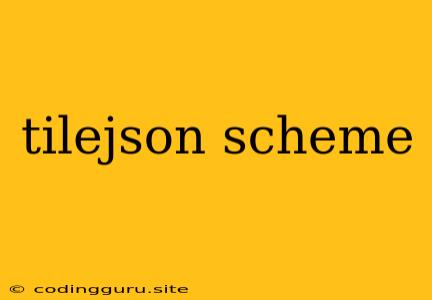Understanding the Power of TileJSON: A Comprehensive Guide
TileJSON is a simple JSON specification that provides a standardized way to describe tile sets for use in web mapping applications. It offers a convenient method to define the location of tiles, their resolution, and other vital information, making it a crucial component for building interactive maps.
What is TileJSON and Why is it Important?
Imagine creating a map using tiles. You'll need to specify where each tile is located, its size, the extent of the map, and various other details. TileJSON comes to the rescue by providing a structured way to describe all this information, ensuring consistency and ease of use across different mapping tools and applications.
Key Elements of a TileJSON Scheme
A TileJSON document is a JSON object with a specific set of properties. Here are some of the key elements you'll encounter:
tile: This property defines an array of URLs that point to the tiles. Each URL includes placeholders for the tile's coordinates and zoom level.minzoom: The minimum zoom level for the tile set.maxzoom: The maximum zoom level for the tile set.bounds: An array of four numbers representing the geographic bounds of the tile set in the order: west, south, east, north.attribution: A string that indicates the source of the tile data, typically used to display attribution information.scheme: The tiling scheme used by the tiles. This can be either "xyz" or "tms". The "xyz" scheme is more common and used by libraries like Leaflet and Mapbox GL JS.
Understanding TileJSON Schemes
The scheme property in TileJSON defines the tile coordinate system used. This is crucial for correctly interpreting and displaying tiles on a map.
xyzscheme: This is the most prevalent scheme used in modern web mapping libraries. It follows a straightforward system where the first coordinate represents the column number (x), the second coordinate represents the row number (y), and the third coordinate represents the zoom level (z).tmsscheme: This scheme is older and follows a different coordinate system. The y-coordinate is flipped, meaning the top row starts at y=0 and the bottom row at y=2^z - 1.
Creating Your Own TileJSON
You can create a TileJSON document manually using a plain text editor or generate one using tools like TileServer-GL.
Here's a simple example of a TileJSON document:
{
"tile": [
"https://{s}.tile.openstreetmap.org/{z}/{x}/{y}.png"
],
"minzoom": 0,
"maxzoom": 19,
"bounds": [
-180,
-85.05112877980656,
180,
85.05112877980656
],
"attribution": '© OpenStreetMap contributors'
}
This example points to Open Street Map tiles, specifying the tile URL, minimum and maximum zoom levels, geographic bounds, and attribution information.
Utilizing TileJSON in Your Web Mapping Projects
TileJSON plays a pivotal role in integrating tile sets into your web mapping applications. It acts as a bridge between the tile data and your mapping library, enabling seamless map rendering. Most popular mapping libraries like Leaflet and Mapbox GL JS have built-in support for TileJSON, allowing you to easily load and display tiles from various sources.
Benefits of Using TileJSON
- Standardization: TileJSON provides a consistent structure for describing tile sets, making it easier to exchange data between different tools and libraries.
- Simplicity: The JSON format is easy to understand and manipulate, making it convenient to work with tile sets.
- Flexibility: TileJSON supports various tile coordinate systems and provides options for specifying metadata, making it suitable for different types of map data.
Conclusion
TileJSON is an indispensable tool for anyone working with tile-based maps. It provides a structured and standardized way to describe tile sets, simplifying the process of integrating and displaying map data in web applications. Understanding the key elements and schemes of TileJSON allows you to effectively leverage its power for building interactive and dynamic maps.
